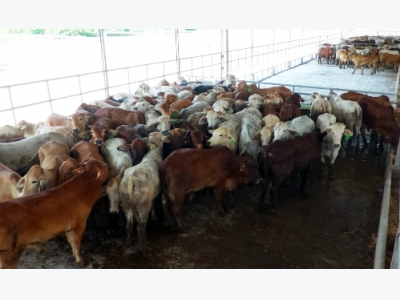Vietnams taste for beef soars, but cattle industry cant find its feet

Cows imported from Australia at a farm in southern Vietnam. Photo by VnExpress/Cuu Long
Local supplies of beef and buffalo meat satisfy only 80 percent of domestic demand.
Vietnam’s cattle industry is failing to meet the country's increasing demand for beef, forcing local consumers to turn to imported products.
Last year, the country imported more than 262,300 live cattle, and nearly 42,000 tons of beef and buffalo meat, valued at more than $410 million, according to the Animal Husbandry Department under the Ministry of Agriculture and Rural Development.
Explaining the reason for the imports, vice head of the department Tong Xuan Chinh said Vietnamese people’s diets have changed drastically in recent years, and they're now eating more beef and buffalo meat.
Average consumption has doubled to 5-6 kilograms of beef and buffalo meat per year in the past decade, but the cattle industry has been unable to keep up with the pace. Local supplies of beef and buffalo meat only meet 80 percent of the current demand.
“Imports of beef and buffalo meat are unavoidable due to limited local supplies,” said chairman of the Vietnam Animal Husbandry Association Nguyen Dang Vang. “We don't have the policies needed to develop the cattle industry.”
Imported beef, mainly from Australia and the U.S., is available in air conditioned supermarkets, modern food stores and local markets, and some restaurants are also using imported beef in their dishes.
Many local consumers favor imported products thanks to their reasonable prices and food safety concerns that have plagued the Vietnamese food market in recent years. Beef imported from Australia and the U.S. costs from VND100.000-500.000 ($4.4-22.02) per kilogram, around the same price as local products.
“It tastes good and it's not too expensive,” housewife Nguyen Thi Nga, 42, from Hanoi’s Dong Da District, said while buying Australian beef at local supermarket Vinmart.
Consumers like Nga are expected to drive Vietnam’s imports of beef and buffalo meat.
This rising demand is mainly because Vietnamese consumption of beef and buffalo meat is still low. Beef accounts for 23 percent of the world’s total meat consumption, while beef and buffalo meat make up just 7 percent of the Vietnamese diet, Vang said. The most popular meat in the country is pork.
Low profits, low interest
Despite the demand, Vietnam has been struggling to develop its cattle industry. According to the Ministry of Agriculture and Rural Development, the country does not have the conditions to expand the industry.
The hot weather is not suitable for raising cattle, experts said, while low quality livestock has affected output. The weight of cattle reared in Vietnam is 30-50 percent less than animals raised in Australia or the U.S.
Limited land is another obstacle for the cattle industry. Chinh from the Animal Husbandry Department said that cattle need large areas to graze. Countries with developed cattle industries like Australia, New Zealand and the U.S earmark one hectare of land per cow, while that space in Vietnam is much smaller.
Expanding infrastructure construction in rural areas has also contributed significantly to this problem in Vietnam, he said.
Limited grazing land and the investment needed to breed cattle that can turn a profit have caused local enterprises to lose interest. Cattle in Vietnam are mostly raised by smallholdings with 5-7 animals each, according to the Animal Husbandry Department.
A small cattle farm can be profitable if farmers use their own crops to feed the animals, but large-scale breeding is not because of high input costs, said industry insiders.
The number of cows and buffaloes raised in Vietnam has fallen to five million now from nearly seven million in 2006, according to the Vietnam Animal Husbandry Association.
Chinh said Vietnam should take advantage of the rising demand for beef by importing high quality breeding stock, accelerating animal feed production, and adopting new technologies in production.
By developing each stage of the production chain, from feed production, to breeding and slaughtering, Vietnam could cut its reliance on imported beef, he said.
Có thể bạn quan tâm
 S Korea to adopt tracking system for poultry supply chain
S Korea to adopt tracking system for poultry supply chain About 10 per cent of poultry and eggs will be subject to the pilot programme, and the system will be fully implemented in December 2018
 Agro-forestry-fishery exports exceed $3 billion in January
Agro-forestry-fishery exports exceed $3 billion in January Export turnover of agro-forestry-aquatic products in January 2018 was estimated at 3.09 billion USD, up 25.9 percent against the same period last year.
 Việt Nam plans to export fruits to Qatar
Việt Nam plans to export fruits to Qatar Việt Nam can fully meet Qatar’s demand for tropical fruits, said Minister of Agriculture and Rural Development (MARD) Nguyễn Xuân Cường.